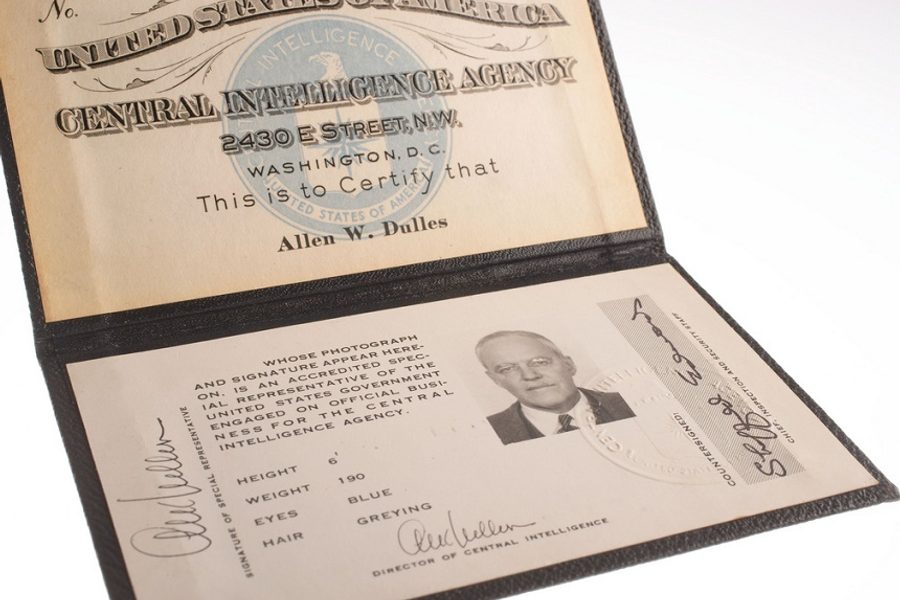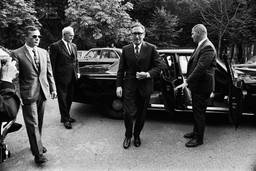Allen Dulles and the Cold War Within the National Security State
Looking back to the origins of the national security state helps us understand its power and scope today.
Joseph Fronczak

After the CIA first set up detention centers at black sites overseas, the agent overseeing the program bluntly explained the logic of holding interrogations outside U.S. territory in an internal memorandum: doing so would allow the agency to conduct “certain activities which were not permitted by the United States government.”
The agent’s language is striking not only for its bluntness, but also for its assumption that moving offshore legitimized its behavior. Even more striking is the agent’s choice of words, which implied that the CIA existed somehow outside of “the United States government” and was empowered to operate outside its purview. But today, what is perhaps most striking about the memo is that it was written in 1951.
Its author was Allen Welsh Dulles, who became the CIA’s director two years after he wrote his memo on “Interrogation Techniques,” in which he went on to discuss “the possibilities of augmenting the usual interrogation methods by the use of drugs, hypnosis, shock, etc…” The ellipses are his; Dulles was an elliptical man and he is the titular devil in David Talbot’s new book, The Devil’s Chessboard: Allen Dulles, the CIA, and the Rise of America’s Secret Government.
Talbot, a former editor at Mother Jones and founder of the progressive news site Salon, writes of enhanced interrogation techniques and black sites, as well as extraordinary rendition, assassination programs, regime change, politically-motivated intelligence leaks and mass surveillance abroad and at home — all part of CIA standard operating procedure during the agency’s early years at the onset of the Cold War.
The National Security Act of 1947 established the CIA, but during Dulles’s directorship from 1953 to 1961, the agency established itself as the world-historic force recognizable today. Under Dulles, the agency took part in overthrowing Iran’s democratically-elected prime minister Mohammad Mossadegh, toppled Guatemala’s democratically-elected president Jacobo Arbenz, attempted to assassinate the Cuban revolutionary leader Fidel Castro and was involved in the killing of the Congo’s first democratically elected prime minister, Patrice Lumumba.
Buoyed by successes in Guatemala, Iran and the Congo, and unfazed by failures in Cuba as well as in other countries like Indonesia, Dulles’s CIA waded into disaster with its April 1961 Bay of Pigs invasion. Certainly, the Bay of Pigs was a personal disaster for Dulles: John F. Kennedy, who months earlier as president-elect had concluded that he lacked the clout to oust Dulles, now succeeded in pushing him out in classic Machiavellian fashion: awarding him the National Security Medal one day, accepting his resignation the next.
Talbot attends to these more-or-less familiar CIA plots, but he usefully emphasizes instead the lesser-known psychological offensives of Dulles’s CIA, which culminated in MKUltra, the agency’s wildly ambitious mind-control program.
MKUltra and its predecessors were experiments in black-site detention, extraordinary rendition, and enhanced interrogation techniques: the bread and butter of the 21st-century national security state. Indeed, in Talbot’s rendering, Dulles was the central figure in the national security state’s constitution. In his efforts to produce a readable yarn, Talbot considerably exaggerates both Dulles’s importance and his personal treachery, to the detriment of his book’s broadest, and most imperative, point: that today’s vast shadow state first germinated in the paranoias, fears, and ambitions of America’s foreign policymakers of the Cold War.
It is ironic that Dulles, whose career was made by conventional intelligence fieldwork in the CIA’s wartime predecessor, the OSS, would put such great faith in enhanced interrogation techniques. Even now, in the aftermath of the report by Senator Dianne Feinstein’s committee on CIA detention and interrogation practices, with its revelations of sleep-deprived hallucinations, “rectal rehydration,” and mock executions, it remains nonetheless startling just how radically Dulles sought to enhance interrogation a half century earlier.
In April 1953, only one month into his tenure, Director Dulles gave a speech to alumni of his alma mater, Princeton, warning of Soviet “brain warfare.” He told the alumni, “The human mind is the most delicate of all instruments. … The Soviets are now using brain-perversion techniques as one of their main weapons in prosecuting the Cold War.” Though Dulles added that such techniques were “so abhorrent to our way of life that we have recoiled from facing up to them,” the CIA was already conducting its own brain warfare with interrogation experiments, as Dulles knew well.
The program Dulles had been in charge of when he’d written his 1951 memo, Operation Artichoke (named for his vegetable of choice), ran out of secret prisons scattered around the world, including a former Nazi interrogation center near Frankfurt captured by U.S. forces in 1945. U.S. intelligence kept the detention facility intact to hold Nazi prisoners including Hermann Goering and Albert Speer, renaming it Camp King.
After the war was over, Camp King remained open, switching its focus from Nazi prisoners to Soviet ones — as the Cold War intensified, some Nazi prisoners willing to share intelligence on the Soviets were set free, even put on US and British payrolls. At Camp King, US officials drew on Gestapo methods and worked with ex-Gestapo agents and scientists from the Nazi regime to conduct enhanced interrogations. An internal CIA memo described the nearby Haus Waldhof as an agency “safe house” where interrogators known as “rough boys” employed “Artichoke techniques” and tortured Soviet prisoners — to death, in some cases.
Though President Harry Truman signed the National Security Act, approving the CIA’s creation, he also registered reservations. He feared that such an agency would grow into a Gestapo unchecked by oversight. Already in Dulles’s day, the CIA was exceeding its mandate. Since then, however, the secret government that Talbot describes in embryo in Operation Artichoke and MKUltra has grown to rival America’s public government of elected representatives and checks and balances.
A 2010 series of investigative reports by Washington Post journalists Dana Priest and William Arkin found 1,271 government organizations and 1,931 private companies engaged in “programs related to counterterrorism, homeland security and intelligence.” Priest and Arkin described the construction since September 2001 of top-secret complexes “the equivalent of almost three Pentagons or 22 U.S. Capitol buildings.” It is, of course, a boilerplate conservative complaint that government has outgrown what the Constitution’s framers endorsed, but that’s only the half of it: America has not just built one leviathan, it’s built two.
This duality is critical to understanding the national security state — as Dulles himself understood it, as distinct from the U.S. constitutional state. Beyond its value in tracing the Cold War origins of the national security state, The Devil’s Chessboard has its greatest value in its intriguing depiction of the two distinct U.S. states engaged in their own ongoing, and growing, cold war with each other.
According to historian Arthur Schlesinger Jr.’s Vietnam War-era warning of “the imperial presidency,” the executive branch controlled the national security machinery and accordingly accrued uncheckable power, as would an emperor with his praetorians. But today, the dynamics of state power appear much more complex. Barack Obama’s deference to the national security apparatus has revealed the degree to which it has become an uncheckable force of its own, a shadow sovereign. Schlesinger’s narrative, familiar by now, of expanded executive power relative to congress and the judiciary is, paradoxically, inextricable from the executive’s much less recognized and ever-increasing dependence on the national security state.
Greg Grandin draws a sharp contrast in his recent history, Kissinger’s Shadow, between Schlesinger’s would-be imperial president Richard Nixon, whose fall began with the revelation of his secret and unsanctioned war in Cambodia, and today when Barack Obama can, with an impunity Nixon never enjoyed, compose a “kill list” of individuals for the CIA to target in drone strikes, anywhere in the world. An emperor’s power, to be sure.
Yet against the praetorians, Obama is impotent. Despite his longstanding wishes and the damage done to his legacy, the president still can’t even close the detention center in Guantánamo Bay, where the CIA has conducted its most notorious enhanced interrogations. Indeed, it was during the senate’s attempts to investigate the CIA’s interrogation program that the cold war between the constitutional state and the national security state spilled into the open. When Senator Feinstein charged, accurately, that the CIA had broken into Senate staff computers, CIA director John O. Brennan insisted “nothing could be further from the truth,” dismissing the charge as “beyond the scope of reason.”
Obama was necessarily passive, explaining it would not be an “appropriate role for me and the White House to wade in at this point.” When Feinstein’s charges were confirmed, Obama found that it would still be an inappropriate role for him and the White House to wade in, and professed his “full confidence in John Brennan.” Heckuva job, if ever there was one. But Talbot’s account of national-security state power suggests it’s a mistake to consider Obama’s enduring devotion to Brennan as an act of loyalty freely given, as if Brennan didn’t know where Obama’s bodies are. He does; as CIA director, he holds the kill list.





